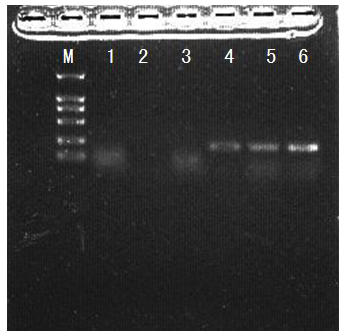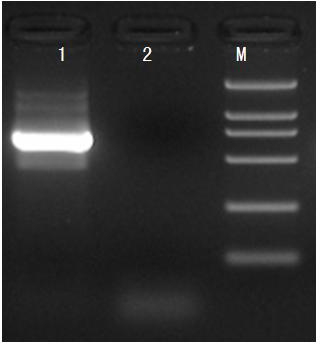Cloning method of perinereis aibuhitensis metal binding protein gene
A metal-binding protein and a technology for B. biloba, applied in the field of genetic engineering, can solve the problems of inability to deeply study functional characteristics, regulatory mechanisms, affecting the wide application of B. biloba, etc., and achieve the effect of being beneficial to cost and rich in sources.
- Summary
- Abstract
- Description
- Claims
- Application Information
AI Technical Summary
Problems solved by technology
Method used
Image
Examples
Embodiment 1
[0043] The method for cloning the metal-binding protein gene of P. didentate is as follows:
[0044] one. Extract and purify the total RNA of P. didentate, and synthesize the first strand of cDNA;
[0045] 1. Extraction and purification of total RNA: Trizol from Invitrogen was used. The electrophoresis of the extracted and purified total RNA is as follows: figure 1 shown. Wherein, M is the molecular weight marker, and 1-2 is the purified total RNA.
[0046] 2. cDNA first-strand synthesis: using the Takara RNA PCR Kit (AMV) Ver.3.0 kit, mix the following reagents:
[0047] Mgcl 2 2μl
[0048] 10× reverse transcription buffer 1 μl
[0049] RNase Free dH 2 O 3.75 μl
[0050] dNTP 1 μl
[0051] RNase inhibitor 0.25 μl
[0052] AMV reverse transcriptase 0.5 μl
[0053] Adapter primer Oligo dT 0.5 μl
[0054] Total RNA 1 μl
[0055] 10 μl total volume
[0056] Reverse transcription reaction conditions: 30°C...
PUM
 Login to View More
Login to View More Abstract
Description
Claims
Application Information
 Login to View More
Login to View More - R&D
- Intellectual Property
- Life Sciences
- Materials
- Tech Scout
- Unparalleled Data Quality
- Higher Quality Content
- 60% Fewer Hallucinations
Browse by: Latest US Patents, China's latest patents, Technical Efficacy Thesaurus, Application Domain, Technology Topic, Popular Technical Reports.
© 2025 PatSnap. All rights reserved.Legal|Privacy policy|Modern Slavery Act Transparency Statement|Sitemap|About US| Contact US: help@patsnap.com



